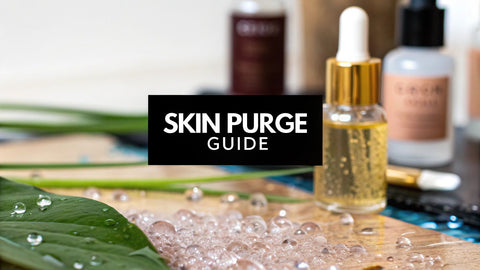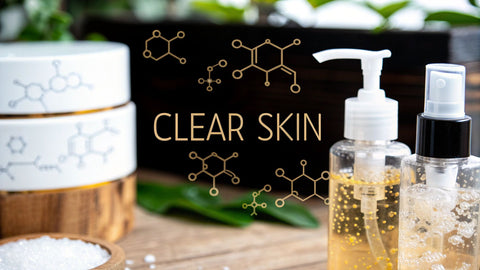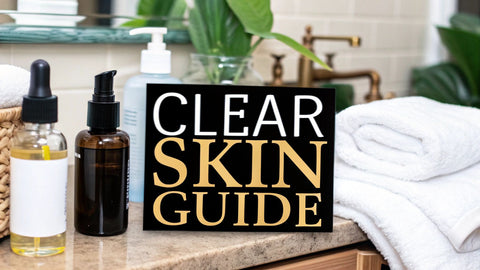Adapalene vs Tretinoin: A Guide for Clear Skin

When it comes to adapalene vs tretinoin, your skin's biggest challenge is the deciding factor. Adapalene, a newer and gentler retinoid, is fantastic for mild-to-moderate inflammatory acne, especially if you have sensitive skin. It’s also conveniently available over-the-counter. Tretinoin, on the other hand, is a prescription-only powerhouse, celebrated for its potent anti-aging effects and its ability to tackle stubborn acne.
Adapalene vs Tretinoin: Your Quick Comparison
Diving into the world of retinoids can feel overwhelming. But once you grasp the key differences between these two, you're well on your way to clearer, healthier skin. Both are derivatives of Vitamin A that speed up skin cell turnover, but they don't work in quite the same way. This makes each one better suited for different skin types and goals.
Adapalene is what’s known as a third-generation retinoid, meaning it's more selective. It hones in on the specific skin cell receptors that control inflammation and clogged pores. This targeted approach makes it a highly effective acne treatment that most people's skin can handle without a major freak-out.
Tretinoin is a first-generation retinoid with a much broader approach. It influences a wider array of cellular processes, which is why it's so good at stimulating collagen and smoothing out wrinkles. That said, this broad action is also what makes it more likely to cause that infamous initial irritation.
At a Glance Adapalene vs Tretinoin
To make things simple, here’s a quick rundown of what sets these two retinoids apart. This table breaks down the essentials so you can see the core differences at a glance.
| Feature | Adapalene | Tretinoin |
|---|---|---|
| Primary Use | Mild to moderate acne, particularly inflammatory acne. | Persistent acne, fine lines, wrinkles, and sun damage. |
| Availability | Over-the-counter (0.1% strength) and prescription. | Prescription only. |
| Potency | Potent for acne with a lower risk of irritation. | Highly potent for both acne and anti-aging. |
| Irritation Potential | Lower. Generally better tolerated by sensitive skin. | Higher. More likely to cause initial dryness, redness, and peeling. |
| Best For | Individuals new to retinoids or with sensitive, acne-prone skin. | Individuals with resilient skin focused on anti-aging or severe acne. |
| Key Benefit | Targeted anti-inflammatory action for faster acne relief. | Gold standard for proven anti-aging and collagen production. |
Think of this as your starting point. The best choice always comes down to what your skin needs most and what it can tolerate.
Visualizing the Timeline and Tolerance
Seeing the data can really put things into perspective. The infographic below maps out the typical user experience, showing how long it takes to see results and how likely you are to experience irritation with each one.
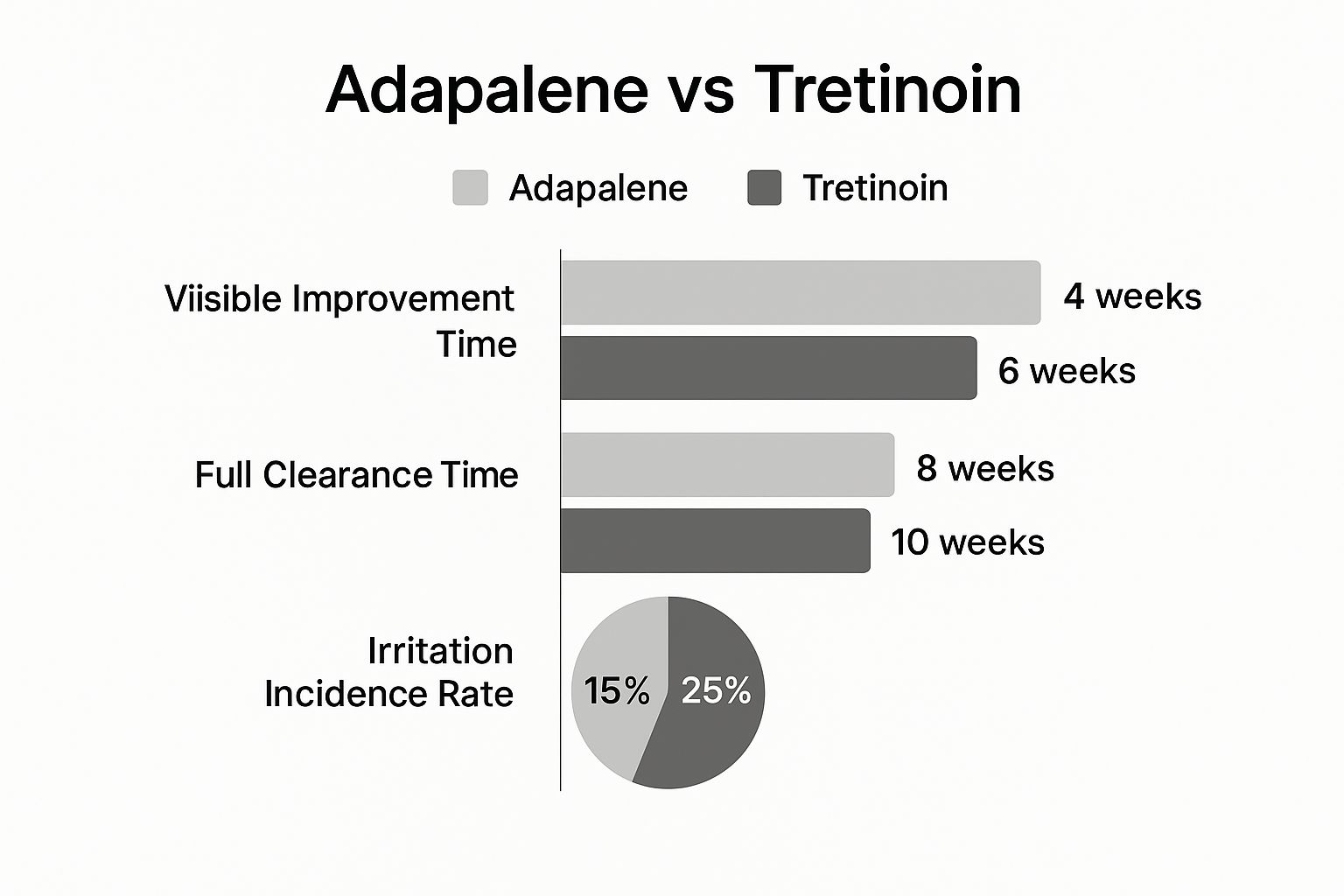
What this shows us is pretty clear: while both get the job done, adapalene often works faster on acne with a much lower chance of irritation. This is exactly why it's such an excellent and comfortable starting point for so many people. Ultimately, you have to weigh your need for raw power against your skin's sensitivity.
Understanding How Retinoids Transform Your Skin
To really get into the adapalene vs. tretinoin debate, we first need to pull back the curtain on how they actually work. As experts in active ingredient skincare, Neutralyze believes in empowering you with knowledge. Both are powerful compounds derived from Vitamin A, known as retinoids, and they fundamentally change your skin's behavior at the cellular level. This isn't just a surface-level fix; they get to the root of what causes acne and signs of aging.
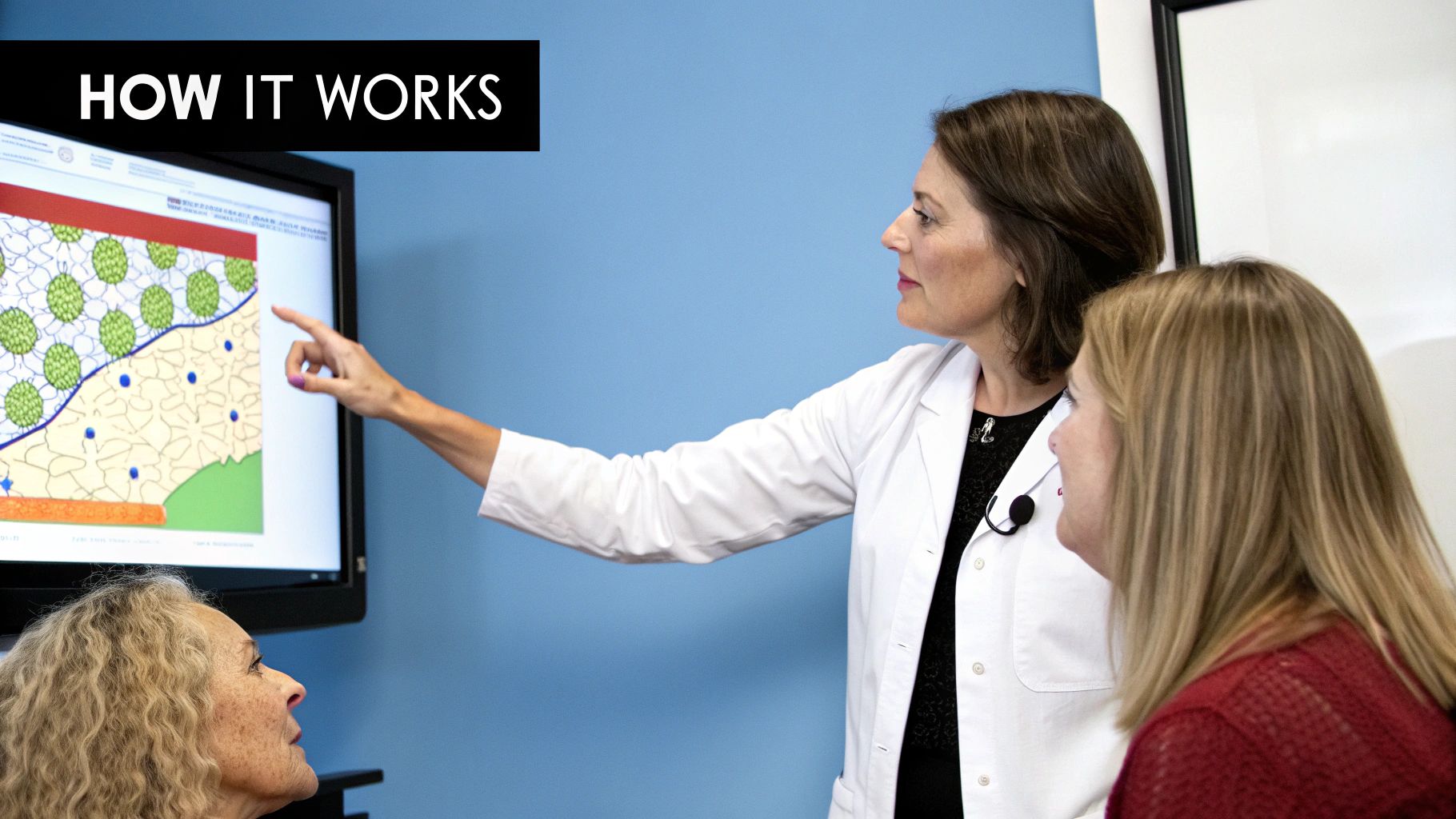
It all starts when a retinoid molecule binds to specific sites in your skin cells called retinoic acid receptors (RARs). Think of these receptors as locks and the retinoid as the perfect key. Once that connection is made, the retinoid signals your cells to accelerate their lifecycle—a process we call cell turnover. This rapid renewal pushes out the dead skin cells that clog pores, which means fewer breakouts. At the same time, it revs up the production of collagen, the protein that keeps skin firm, plump, and smooth.
The Power of Tretinoin: Broad-Spectrum Action
Tretinoin is a first-generation retinoid, and its power lies in its broad, non-selective approach. It doesn't just knock on one door; it kicks them all down, binding to all three main types of retinoic acid receptors (RAR-alpha, RAR-beta, and RAR-gamma). This all-encompassing action is precisely what makes it the gold standard for anti-aging. By activating so many cellular pathways, it delivers dramatic improvements in collagen, fine lines, and overall skin texture.
But that raw power comes with a trade-off. Because it's so potent and affects such a wide range of cellular functions, tretinoin has a much higher potential for causing irritation. The intense redness, peeling, and dryness—often called "retinization"—are far more common with tretinoin because of its comprehensive mechanism.
First approved by the FDA way back in 1971, tretinoin (also known as all-trans retinoic acid) has been a dermatological workhorse for decades. The global market for it was valued at around $1.3 billion in 2023 and is projected to hit $2.4 billion by 2032, thanks to the high prevalence of acne and a growing focus on skin health. You can find more insights into the tretinoin market and its growth on datamintelligence.com.
The Precision of Adapalene: Targeted Efficacy
Adapalene represents a more modern, strategic approach. As a third-generation retinoid, it was engineered for precision. Instead of carpet-bombing all receptors like tretinoin, adapalene selectively targets just RAR-beta and RAR-gamma. This is a crucial distinction and the key to its unique profile.
These two specific receptors are heavily involved in the inflammation and pore-clogging processes (comedogenesis) that fuel acne. By focusing all its energy on these specific pathways, adapalene delivers powerful anti-acne benefits without triggering the widespread irritation that tretinoin often does.
At Neutralyze, we focus on ingredients that deliver targeted, intelligent results. Adapalene’s precision mechanism is its greatest strength, directly addressing the root causes of inflammatory acne with a much lower risk of side effects. It’s a smarter, more tolerable solution for most people struggling with breakouts.
Its unique molecular design makes it more stable and less irritating than older retinoids. This is why a product like Neutralyze Adapalene Gel 0.1% can offer prescription-strength results with the gentleness and accessibility of an over-the-counter treatment.
Acne vs. Anti-Aging: Which Retinoid Reigns Supreme?
Once you get past the science, the real question in the adapalene vs. tretinoin debate is a practical one: which one is going to work for me? The answer really boils down to whether you're fighting acne or the signs of aging. Each of these retinoids has its own specialty, and they excel in different areas based on how they interact with your skin.
If you’re dealing with acne, what you want most is to see those painful, red blemishes disappear—and fast. This is where adapalene truly shines. Its knack for targeting the specific skin receptors involved in inflammation means it gets to work quickly, calming down angry breakouts with impressive efficiency.
Tretinoin is a powerhouse against acne, too, but its broad, aggressive action can trigger a more intense "purging" phase. That initial period where breakouts get worse before they get better can be really discouraging. For many, adapalene offers a smoother, faster, and more comfortable path to clear skin, especially for inflammatory acne.
Adapalene for Acne: A Precision Strike
Adapalene’s strength is its precision. It selectively targets the receptors that control skin cell turnover inside the hair follicle while also calming inflammation. By zeroing in on the two main causes of acne, it delivers some serious benefits.
- Quick Anti-Inflammatory Relief: Adapalene often reduces the redness and swelling of pimples faster than tretinoin can.
- Keeps Pores Clear: It’s great at normalizing how skin cells shed, preventing the buildup that leads to blackheads and whiteheads.
- Way More Tolerable: Because it doesn’t activate all of the skin's retinoic acid receptors, it causes much less irritation. This is a game-changer.
That last point is key. A skincare treatment is useless if you can't stick with it. Adapalene's gentler nature means you can stay consistent without the intense peeling and redness that often come with tretinoin. A product like Neutralyze Adapalene Gel 0.1% is formulated to give you these powerful, targeted results in a way that’s easy to slip into your daily routine.
Tretinoin for Anti-Aging: The Collagen King
But when the conversation shifts from clearing breakouts to fighting wrinkles, the tables turn completely. Tretinoin’s broad-spectrum activity—the very thing that makes it potentially irritating—becomes its greatest strength for anti-aging. By activating a wider range of cellular pathways, it kicks off a much deeper and more comprehensive renewal process in the skin.
This is exactly why tretinoin is the undisputed gold standard for reversing sun damage (photoaging). Its ability to fire up new collagen production is simply unmatched by other topical retinoids.
Tretinoin doesn't just clear pores; it rebuilds the very foundation of your skin. It works by thickening the dermis, smoothing out wrinkles from the inside, and fading dark spots, delivering a level of rejuvenation few other ingredients can touch.
Adapalene does offer some mild anti-aging perks by promoting cell turnover, but it just can't compete with the serious collagen-boosting power of tretinoin. If your primary goal is to soften fine lines, improve skin texture, and fade age spots, tretinoin is the more potent—albeit more aggressive—choice.
Efficacy and Tolerance Profile Breakdown
To make the choice clearer, let's break down how these two stack up side-by-side. The right one for you depends on what you're trying to achieve and what your skin can handle.
| Comparison Point | Adapalene (e.g., Neutralyze Adapalene Gel) | Tretinoin |
|---|---|---|
| Primary Use Case | Inflammatory & Comedonal Acne | Anti-aging, Photoaging, Severe Acne |
| Acne Efficacy | Excellent. Often shows results faster for inflammatory acne. | Excellent. Highly effective but may have a longer "purging" period. |
| Anti-Aging Efficacy | Mild. Promotes cell turnover but has limited impact on collagen production. | Gold Standard. Unmatched ability to boost collagen and reduce fine lines. |
| Speed of Action | Faster for reducing inflammation in acne. | Slower initial acne improvement due to purge; long-term anti-aging results. |
| Common Side Effects | Mild to moderate dryness, peeling, and redness. | Moderate to severe dryness, peeling, redness, and sun sensitivity. |
| Overall Tolerability | High. Significantly gentler and suitable for most skin types, including sensitive. | Low to Moderate. Often requires a careful, slow introduction to manage irritation. |
Ultimately, this table shows a clear trade-off: Adapalene offers targeted, well-tolerated acne treatment, while Tretinoin provides powerful, comprehensive anti-aging benefits at the cost of higher potential for irritation.
Weighing the Side Effect Profiles
Clinical studies consistently back this up, showing a clear difference in how well each retinoid is tolerated. Adapalene not only demonstrates a faster onset of anti-inflammatory action but also comes with significantly fewer reports of irritation, scaling, and redness.
In fact, studies have found that adapalene users experience approximately 20-30% fewer adverse skin reactions. That's a huge difference, and it leads to much better adherence—people actually stick with the treatment. This statistical edge makes adapalene a much better starting point for most people, especially if your skin is sensitive or reactive.
While topical retinoids are fantastic, it's always smart to think about your skin's health holistically. For example, some people explore complementary wellness practices. There are even discussions around infrared sauna skin benefits, which some suggest can help with circulation and collagen support, working in harmony with your overall skincare goals.
Choosing the Right Retinoid for Your Skin
Picking between adapalene and tretinoin can seem complicated, but it gets a lot easier when you stop thinking about the science and start thinking about your own skin. The best choice really comes down to your specific situation. By figuring out where you land, you can pick the retinoid that will give you the best results with the least frustration.
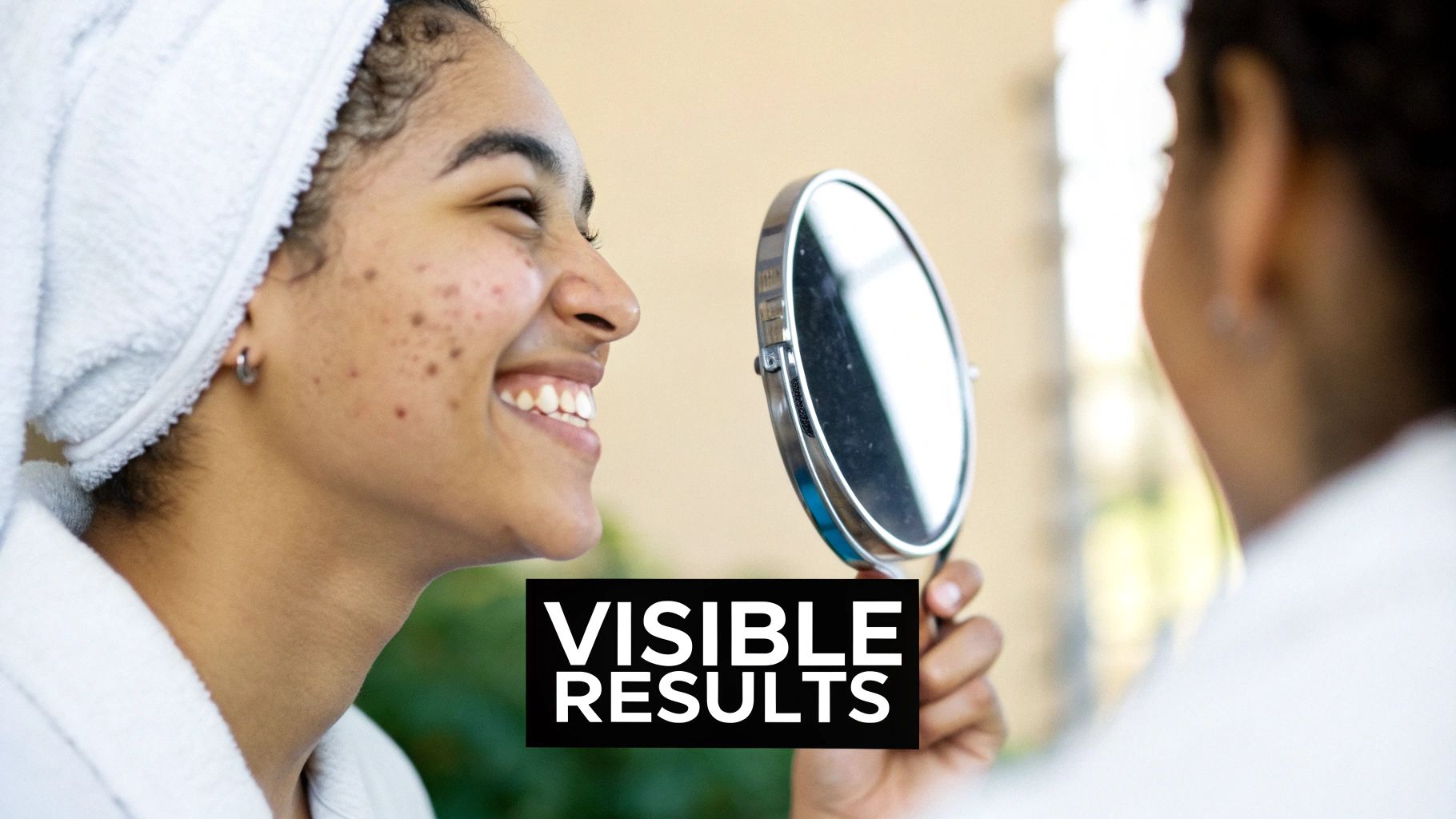
So, let's look at some real-world examples. Each of these profiles represents a common skincare journey. Find the one that sounds the most like you, and you’ll have your answer.
Scenario 1: The Teenager with First-Time Acne
This is someone dealing with classic teenage acne—a mix of blackheads, whiteheads, and some red, angry pimples, usually around the T-zone. Their skin has never been on an active treatment before, so it's likely to get irritated easily. The goal is simple: clear the breakouts without making their skin angry.
- The Challenge: Hormonal shifts are kicking oil production into overdrive, clogging pores and causing inflammation.
- The Best Choice: Adapalene.
- The Rationale: Adapalene is a specialist when it comes to calming down the inflammation behind pimples. More importantly, it's much gentler than tretinoin, meaning a teenager is far more likely to stick with it consistently. Starting with an accessible over-the-counter option like Neutralyze Adapalene Gel 0.1% is a perfect first step into a solid skincare routine.
Scenario 2: The Adult with Sensitive Skin and Breakouts
This person is navigating that tricky combination of adult acne and sensitive skin. They might already deal with redness, rosacea, or just a skin barrier that complains about everything. Their priority is finding something that gets rid of blemishes without causing a flare-up of irritation or dryness.
- The Challenge: How do you treat acne while also protecting a skin barrier that's already compromised or easily upset?
- The Best Choice: Adapalene.
- The Rationale: Tretinoin's raw power would likely be way too much here, leading to major irritation. Adapalene was practically designed for this exact situation. It delivers impressive anti-acne results with a much lower risk of side effects, making it the clear choice for managing breakouts while keeping sensitive skin happy.
Key Insight: When your skin is sensitive or reactive, the best treatment is the one you can actually use every day. Adapalene's gentler nature makes it the winner for getting long-term results without wrecking your skin's barrier.
Scenario 3: The Individual Focused on Reducing Wrinkles
This person's main goal isn't acne. They're looking for the heavy hitter that can smooth out fine lines, improve skin texture, and help with firmness. Their skin is generally pretty tough and can handle a more intense treatment.
- The Challenge: Revving up collagen production and cell turnover to combat the signs of sun damage and aging.
- The Best Choice: Tretinoin.
- The Rationale: When it comes to anti-aging, tretinoin is the undisputed gold standard. Because it works on all retinoic acid receptors, it kicks off a much more powerful collagen-building response than adapalene. For someone whose main goal is rejuvenation, the potential for more initial irritation is a worthwhile trade-off for its unmatched, proven results. This is a prescription-only path, so you'll need to work with a dermatologist.
Scenario 4: Someone with Stubborn Acne and Scarring
This individual has been fighting a long battle with persistent, maybe even cystic, acne. Now they're worried about both the active breakouts and the textured scars or dark marks left behind. They’ve probably tried other treatments that just didn't cut it and need something with more muscle.
- The Challenge: Tackling severe inflammation, stopping deep breakouts in their tracks, and encouraging skin remodeling to improve texture and scars.
- The Best Choice: Tretinoin (under medical supervision).
- The Rationale: For deep, stubborn acne and the scarring it leaves behind, you often need the firepower of tretinoin. Its ability to dramatically speed up cell turnover helps manage those painful breakouts and can gradually improve the look of scars over time. But because it’s so strong, this journey absolutely must be guided by a dermatologist who can manage the side effects and confirm it's the right move.
For most people starting their journey to clear skin, you don't need to jump straight to the most aggressive option. A highly effective yet well-tolerated solution like Neutralyze Adapalene Gel hits that sweet spot—it’s powerful enough to beat stubborn acne but gentle enough that you can actually stick with it for the long haul.
How to Start Using Retinoids Safely
Getting a retinoid to work for you is all about playing the long game. The whole point is to get clearer, healthier skin with as little irritation as possible. Rushing into it is the fastest way to wind up with a red, flaky mess.
Think of it like this: you can't go from the couch to running a marathon overnight. You have to build up your stamina. It's the exact same idea with your skin—patience and a smart approach are everything.
Start Low and Go Slow
If you remember only one thing, make it this: ease into it. Hitting your skin with a powerful active every single night from the get-go is a recipe for disaster. You’ll trigger so much irritation that you’ll have to stop before you even see the benefits.
- Dial back the frequency: Start by applying your retinoid just 2-3 times a week, only at night. This gives your skin plenty of downtime to recover between applications.
- Check in with your skin: After a couple of weeks, if everything feels fine—no major stinging, peeling, or redness—you can bump it up to every other night. The end goal might be nightly use, but only if your skin tells you it’s ready.
By slowly building up tolerance, you’re training your skin to handle the retinoid without wrecking its protective barrier.
Master Your Application Technique
How you put the product on matters just as much as how often. Slathering on more won't speed up your results, but it’s a surefire way to cause dryness and sensitivity. With retinoids, less is truly more.
You only need a pea-sized amount for your entire face. Seriously. Dot it on your forehead, cheeks, and chin, then gently smooth it over your skin in a thin layer. And remember, this is a preventative treatment, so apply it everywhere you tend to break out, not just on top of existing spots.
Pro Tip: Try the Sandwich Method. If you have sensitive or dry skin, this technique is a lifesaver. First, apply a light layer of moisturizer to clean, dry skin. Wait a few minutes for it to sink in, then apply your pea-sized amount of retinoid. Finish with another layer of moisturizer on top. This creates a buffer that can dramatically reduce irritation without making the retinoid any less effective.
Build a Supportive Skincare Routine
Your retinoid doesn't work in a vacuum. The other products in your routine play a huge supporting role in keeping your skin balanced and happy. A few key steps are completely non-negotiable.
- Cleanse Gently: Stick with a mild, hydrating cleanser. Anything harsh or stripping will only compromise your skin barrier and make it more vulnerable to irritation from the retinoid.
- Moisturize Religiously: Even if your skin is oily, you need a good, non-comedogenic moisturizer morning and night. Retinoids are inherently drying, and keeping your skin hydrated is crucial for it to function properly.
- Sunscreen Is Not Optional: This is the big one. Retinoids make your skin more sensitive to sun damage. You absolutely must wear a broad-spectrum sunscreen with SPF 30 or higher every single day. No exceptions.
- Pause Other Actives (For Now): When you're just starting out, put your other powerful ingredients on hold. That means taking a break from AHAs (like glycolic acid), BHAs (salicylic acid), and maybe even your Vitamin C serum. Once your skin has fully adjusted to the retinoid after a few months, you can slowly reintroduce them, maybe on nights you aren't using the retinoid.
Following these guidelines will make it so much easier to bring a product like Neutralyze Adapalene Gel into your life. It’s formulated to be effective yet gentle, giving you a great starting point on your journey to clear skin.
Why Choose Neutralyze Adapalene for Acne Control
Knowing the difference between adapalene and tretinoin is the first step. The next, and arguably more important one, is picking the right product. At Neutralyze, we believe that the active ingredient is crucial, but the formula it's delivered in makes all the difference. That’s where our Adapalene Gel 0.1% comes in.
We’ve created a formula that combines dermatologist-recommended strength with a delivery system that actually respects your skin. We get it—if a product is harsh and irritating, you're just not going to use it consistently. And consistency is the key to beating acne. Our formula is designed for real-world use, delivering maximum results without wrecking your skin barrier.
A Thoughtful Formula for Sensitive Skin
So many acne treatments take an aggressive, scorched-earth approach, leaving skin red, flaky, and angry. We went in the opposite direction. Our Neutralyze Adapalene Gel 0.1% was intentionally built to be gentle enough for even sensitive, breakout-prone skin.
Here's what makes it different:
- Non-Comedogenic: This is a non-negotiable. Our gel won’t clog your pores, so it’s fighting existing acne without causing new problems.
- Fragrance-Free: We left out all unnecessary fragrances, which are notorious for triggering irritation and sensitivity.
- Dermatologist-Recommended Strength: We stick with the clinically proven 0.1% concentration of adapalene—the sweet spot for effectiveness and tolerability.
When you choose Neutralyze, you're getting more than just an active ingredient; you're getting a complete, science-backed skincare experience. We're focused on creating a product that feels supportive, not punishing, which makes the journey to clear skin a lot more pleasant. You can dive deeper into the specific benefits of adapalene in our detailed guide.
Choosing a retinoid isn’t just about the active ingredient. It’s about the entire formulation. Neutralyze Adapalene Gel is crafted to deliver prescription-strength results while prioritizing your skin’s long-term health and comfort.
As a third-generation synthetic retinoid, adapalene is prized for being tough on acne but gentler on the skin, thanks to its potent anti-inflammatory properties. It's why it's so well-tolerated. This has led to a boom in products designed to make it easy and convenient for anyone to use. You can even discover more insights about the adapalene drugs market on 360iresearch.com.
Think of our Adapalene Gel as a cornerstone of your skincare routine—a foundational piece designed to help you finally get the clear, calm skin you deserve.
Common Questions About Retinoids, Answered
Stepping into the world of retinoids can feel a little confusing, so it’s natural to have questions. Let’s clear up some of the most common ones about adapalene and tretinoin so you can move forward with confidence.
Can I Use Vitamin C with Adapalene or Tretinoin?
Absolutely, but you'll want to be strategic about it. Using them at the same time can lead to irritation and make both ingredients less effective.
The best approach is to split them up. Use your Vitamin C serum in the morning to protect your skin from environmental damage, and reserve your retinoid application for your nighttime routine.
How Long Does the Retinoid "Purge" Last?
That initial breakout phase—the dreaded "purge"—is actually a good sign. It means the retinoid is speeding up cell turnover and clearing out all the gunk that was hiding beneath the surface.
This adjustment period typically lasts anywhere from 2 to 6 weeks. The key is to stay consistent and push through it.
Remember, the purge is temporary. If you stick with your routine, you’ll get past this phase and be on your way to the clearer, smoother skin you’re after.
Is Adapalene Good for Wrinkles?
Adapalene is, first and foremost, an acne-fighting powerhouse. While its ability to boost cell turnover can give you some mild anti-aging perks, that's not its main job.
For a dedicated anti-aging treatment, tretinoin is the clear winner. It's clinically proven to be much more effective at stimulating collagen, which is what really makes a difference in reducing fine lines, wrinkles, and sun damage.
Can I Switch from Adapalene to Tretinoin?
Yes, this is a very common path for people to take. Once your skin is fully adjusted to adapalene, you might decide you want to focus more on anti-aging.
At that point, it’s a great idea to chat with your dermatologist. They can guide you on how to make a smooth and safe transition over to tretinoin.
When your main goal is tackling acne, starting with a well-formulated product that’s both gentle and effective is the smartest move. Neutralyze creates science-backed solutions designed to give you powerful results without causing unnecessary irritation.
Find the right fit for your skin at https://www.neutralyze.com.
